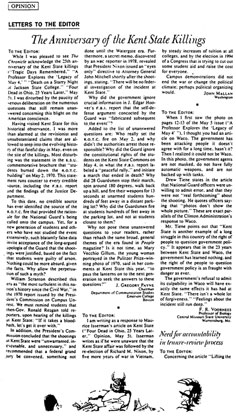1995 Retrospective
Letters, "The Anniversary of the Kent State Killings," Chronicle of Higher Education, June 2, 1995, Vol. 41, Issue 38.
To The Editor:
While I was pleased to see The Chronicle acknowledge the 25th anniversary of the Kent State killings ("Tragic Days Remembered" "A Professor Explores the 'Legacy of May 4,' " "Death on a Starry Night at Jackson State College." "Four Dead in Ohio, 25 Years Later," May 5), I was disturbed by the paucity of serious deliberation on the numerous questions that still remain unanswered concerning this blight on the American conscience.
 Having visited Kent State for this historical observance, I was more than alarmed at the revisionist and unsubstantiated claims that are allowed to seep into the evolving history of that fateful day in May, even on the site of the killings. Most disturbing was the statement in the K.S.U. commemorative brochure that "students burned down the R.O.T.C. building" on May 2, 1970. This statement runs counter to every credible source, including the F.B.I. report and the findings of the Justice Department.
Having visited Kent State for this historical observance, I was more than alarmed at the revisionist and unsubstantiated claims that are allowed to seep into the evolving history of that fateful day in May, even on the site of the killings. Most disturbing was the statement in the K.S.U. commemorative brochure that "students burned down the R.O.T.C. building" on May 2, 1970. This statement runs counter to every credible source, including the F.B.I. report and the findings of the Justice Department.
To this date, no credible source has ever identified the source of the R.O.T.C. fire that provided that rationale for the National Guard's being called onto the campus. Yet, for a new generation of students and others who have not studied the event extensively,such false data invite acceptance of the long-argued apologia of the Guard that the shootings were justified, based on the fact that students were guilty of arson. Nothing could be more absurd, given the facts. Why allow the perpetuation of such a myth?
William Scranton described this era as "the most turbulent in this nation's history since the Civil War," in the 1970 report issued by the The President's Commission on Campus Unrest. We must remind students that then-Gov. Ronald Reagan told reporters, upon hearing of the killings at Kent State: "If it takes a bloodbath, let's get it over with."
In addition, the President's Commission concluded that the shootings at Kent State were "unwarranted, inexcusable, and unnecessary," and recommended that a federal grand jury be convened, something not done until the Watergate era. Furthermore, a secret memo, discovered by an NBC reporter in 1978, revealed that President Nixon issued an "eyes only" directive to Attorney General John Mitchell shortly after the shootings stating, "There will be no Federal investigation of the incident at Kent State."
Why did the government ignore crucial information in J. Edgar Hoover's F.B.I. report that the self-defense argument concocted by the Guard was "fabricated subsequent to the event"?
Added to the list of unanswered questions are: Who set the R.O.T.C. fire May 2, and why didn't the authorities arrest those responsible? Why did the National Guard ignore the constitutional rights of the students on the Kent State Commons May 4, in what they F.B.I. called a "peaceful rally," and initiate a march that ended in death? Why did 28 guardsmen stop their march, spin around 180 degrees, walk back up a bill and fire for 13 seconds at unarmed students hundreds of feet away in a distant parking lot, and not at students closest to them?
Why not pose these unanswered questions to your readers, rather than rehash the same broad, general themes of the era found in People magazine? Is it not time, as Mary Vecchio Gillum, the young woman portrayed in the Pulitzer Prize-winning photo of 1970, said in her comments at Kent State this year, "to pass the lanterns on to the next generation to seek the answers to these questions?"
J. Gregory Payne
Chairman
Department of
Communication Studies
Emerson College
Boston